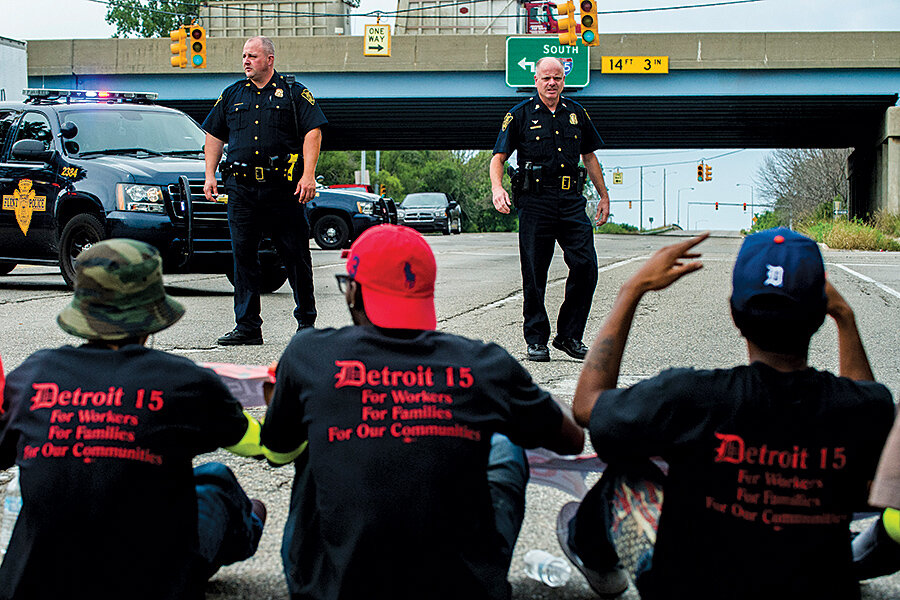How many 'other Fergusons' are there?
Loading...
| Washington
What happened in Ferguson could happen elsewhere in America.
That’s the message from experts on race relations and from an analysis of census data about American cities following the protests in the St. Louis suburb that erupted after the shooting death of an unarmed black 18-year-old at the hands of a white police officer.
Ferguson, Mo., may be an extreme example, but it’s part of a larger pattern in which many US communities have police forces that don’t come close to mirroring the racial composition of the populations they serve. Even where Ferguson-style gaps between the police and wider community don’t exist, it’s common across the United States for blacks to feel that the criminal-justice system is stacked against them and that political power eludes them.
What that means is that, despite the real progress the nation has made on race relations, another tragic occurrence similar to the killing of Michael Brown in Ferguson could spark street protests in other US cities.
How many “other Fergusons” are there in America?
To some extent, that’s a question answered only under the stress of events. But numbers tracked by the US Census Bureau hint at stark racial imbalances that persist.
“I would argue that there are hundreds of potential Fergusons throughout the United States,” says Matthew Whitaker, director of the Center for the Study of Race and Democracy at Arizona State University in Phoenix. “It only takes a gunshot or a death for these simmering feelings to emerge.”
From Ann Arbor, Mich., to Roanoke, Va., some metro areas show up in the 2010 Census database as having no black police officers, even though blacks account for 10 percent or more of their populations.
More common are metro areas such as Atlantic City, N.J., where non-Hispanic blacks are represented on the police force (3 percent in this case) but are a considerably higher share of the overall population (16 percent). Other cities in this category include New Haven, Conn.; Cleveland; and Portland, Ore.
Even in the many metro areas where racial imbalances aren’t so visible, African-Americans are generally concerned about things such as racial bias in policing and criminal justice.
Perceptions of unfairness are widespread. In a 2013 poll five decades after Martin Luther King’s “I have a dream” speech, 7 in 10 blacks said they were treated less fairly in courts and by police than whites. Half said the same about their experience in the job market and in voting, and economic data indicate higher poverty rates among blacks and a significant income gap when compared with whites.
All this suggests that, although the events in Ferguson shook an era of relative racial calm, potentially explosive conditions exist in numerous other places.
“Could it happen elsewhere? Yes,” says Christine Marie Sierra, a University of New Mexico political scientist who focuses on issues of race, ethnicity, and gender. The problem, she says, is a shortfall of both political empowerment and economic equality for people of color.
“There are many places across our country where such despair and inequality could erupt again in protest,” Ms. Sierra says.
Ferguson was an extreme example, judging by some much-publicized numbers. The suburb of 21,000 has evolved to be two-thirds black in overall population, yet its mayor and most city council members are white. Responding to protests and looting after Mr. Brown’s death was a police force of 53, only three of whom were black.
The racial gaps aren’t always that dramatic, according to census data that cover 602 communities with 50,000 or more residents. In most of these cities, blacks either have a much smaller share of the population than in Ferguson, a larger black representation on the police force, or both.
But if the racial divides are often less wide than in Ferguson, they are significant, nonetheless. Consider the census data on people who work in positions of authority in local government – city officials and administrators. (The census doesn’t track the racial composition of city councils.)
In 51 metro areas with populations above 1 million in the census tracking, none showed blacks occupying a share of these positions equal to their share of the population. It’s common in places from Memphis, Tenn., to Philadelphia for blacks to be underrepresented by about half.
Nor are the racial gaps all about blacks and whites. Although events in Ferguson focused the nation on black-white relations, the census data show similar gaps for Latino representation.
Some communities have realized that having a diverse police force is a good thing, “without having their arms twisted,” Mr. Whitaker says. In other cases, progress has come by court order.






